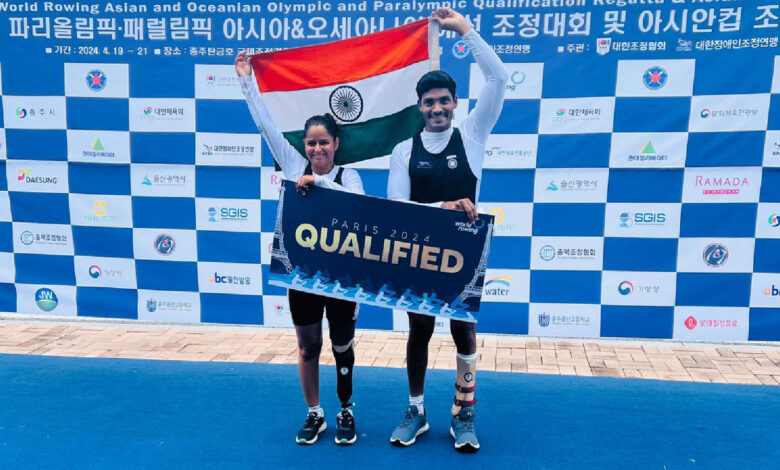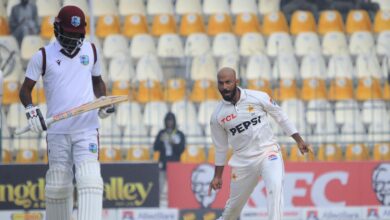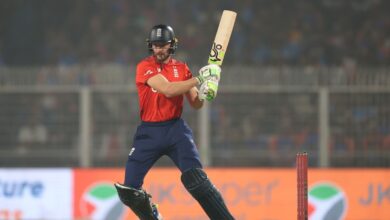Historic Paralympics quota in rowing for India: How Army Rowing Node found Anita to pair with Narayana on Mission Paris 2024 | Sport-others News

Col Ramakrishnan, the Commanding Officer of the Army Rowing Node (ARN) at Pune, vividly recalls the day his most intrepid scout and rowing coach, Subedar Mohammed Azad told him their long search was over. Azad had found the perfect candidate. And the young woman went by the solo name, Anita.
Matching stroke for stroke with mixed doubles sculls partner, Narayana Konganapalle on Sunday morning at Chungju, Korea, Anita helped India win their first-ever para-rowing qualification for the Paralympics, sealing their ticket to Paris.
Anita had been sighted in 2022 posting insane treadmill and deadlift numbers at a Pune gym wearing her artificial leg. A road accident amputee from Rajasthan, living with her sister in Pune at that time, her below-the-knee disability, aligned with the exact specification of a Paralympics category. India could now ambitiously field a mixed doubles para combination, and aim for a medal.
Col Ramakrishnan had cast the net wide to locate the perfect woman para-rower, across the length and breadth of the country, after another conversation months earlier with the other lead protagonist, Havaldar Narayana. The frontline soldier from a humble family in Telangana had been a mine blast survivor in the Valley, a battle casualty who had stepped on an IED, leading to a painful amputation in 2018. He had slowly revived his spirits, picked up para-rowing, and won Nationals, but sensed a stagnant end-line to his career in 2022 because the Asian Games and Paralympics only offered a mixed doubles competition category.
“There was a sense of disappointment after winning Nationals ki iske aage kuchh nahi hai in Narayana (there is nothing left for him going ahead). He wanted to go on leave with a sulk and I was refusing. But he was too good a talent to get demotivated. We had to do something,” Ramakrishnan recalls. “Army per se doesn’t have battle casualty, amputees among its lady soldiers. There’s no accommodation even at ARN for women. But as a fauji, you never lose hope. I was determined to find the best rowing partner for Narayana. We knew chances were slim, but we sounded out all our coaches across India to scan for a woman with a matching disability. Coach Md Azad found Anita,” he adds.

She had great gym metrics for fitness, but there were doubts if she could withstand the rigours of training. “Plus her parents had to agree and were not aware of our search. Fortunately, her father was a jawan from the Defence Security Corps (DSC), posted in Gujarat. He was forthcoming and explained she had to regain self-confidence after her accident. Her siblings were all accomplished, brother a doctor, another sister a banker in the USA, but Anita hadn’t completed her education after the mishap. We asked for a Pune posting for her father in the morning. By evening we had the papers. At ARN we have male rowers only, so the family rented a flat close by,” Ramakrishnan recalls.
The Rowing Federation of India came on board, with president Rajalaxmi Singh Deo agreeing within 10 minutes, to pull off this ambitious Mission Paris qualification for Narayana-Anita. Within two months of knowing nothing of the sport, Anita had shown the ability to withstand sustained stress, mental strength, and good skills on the boat.
Having a lady rower on ARN waters came with other adjustments, Col Ramakrishnan hadn’t anticipated. “Anita doesn’t speak much. Anything you say, she just smiled and said ‘OK, Sir.’ I used to be really confused. Did she get it? Did she not get what we are training? But within 10 months of starting, the duo medalled at Asian Games. That Games setting was overwhelming for her, and Narayana and coaches had to calm her down. But once on the boat, the two were excellent. The medal moment was surreal for us,” he recalls.
In Korea over the weekend, the Indian duo consistently finished 50 seconds ahead of their closest competition, winning finals with 7:50.80. “Asia, we know they’ll top. At the World level, they might still be just Top 6 or Top 8. Anita’s physical parameters are lower compared to European women who tend to be taller, and stronger. She’s an Indian body type, 5 feet 5, and slightly built. But globally they are mostly 46-48 years old, our advantage is both our rowers are young and very gutsy,” he says.
Para rowing is challenging, because when going ahead in the stroke you draw power from the core, while sliding back, it’s very difficult with just one leg. “You can see the pain in Anita’s face, but she gulps it down and is fantastic mentally. Her artificial leg needed changes to the ankle for rowing,” he informs. The rowers were lucky the army’s Artificial Limb Centre was close by in Pune. “They are the best and helped immensely with fitting Anita’s leg.”
Having sealed this first-ever qualification, the ARN is now opening its doors to more women rowers. “We have been dominating the men’s sections (top single scullers Bajrang Lal, Swarn Singh, Dattu Bhokanal). But now we want to recruit female soldiers in rowing and I’m sure one day we will hear our national anthem at the Olympics,” he says. The Army Sports Institute in the city has raised infrastructure for women athletes, and a Girl Sports Company is imminent. But Anita might well have paved the way for ARN to start training women in rowing.
“Now there’s one more girl,” Ramakrishnan says. Pallavi Chaubey, another road accident victim and daughter of a JCO from Army Service Corps, is being readied. “She stayed with Anita for 2-3 months getting initiated. She’ll give her NEET exams and definitely land a good college, but she’s promised to continue para-rowing,” he declares. “Anita-2 has to be ready for the next Asian Games.”




